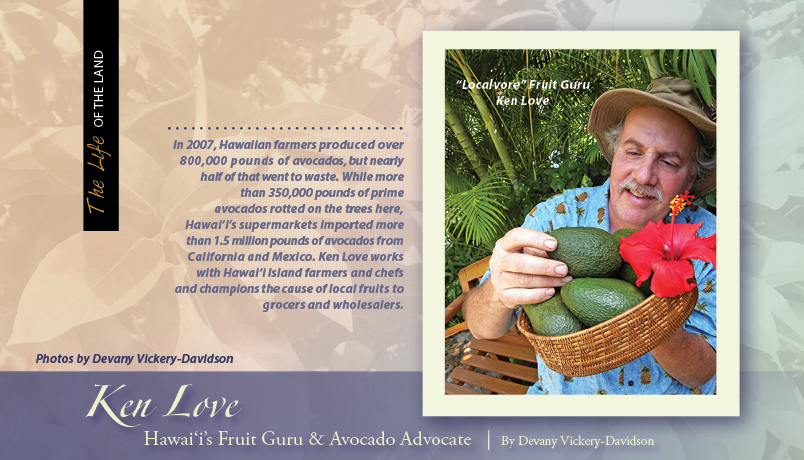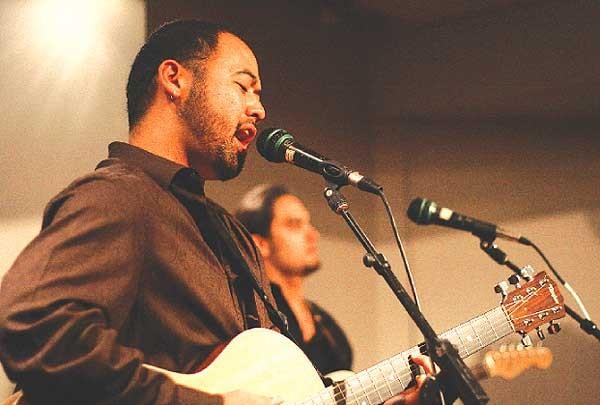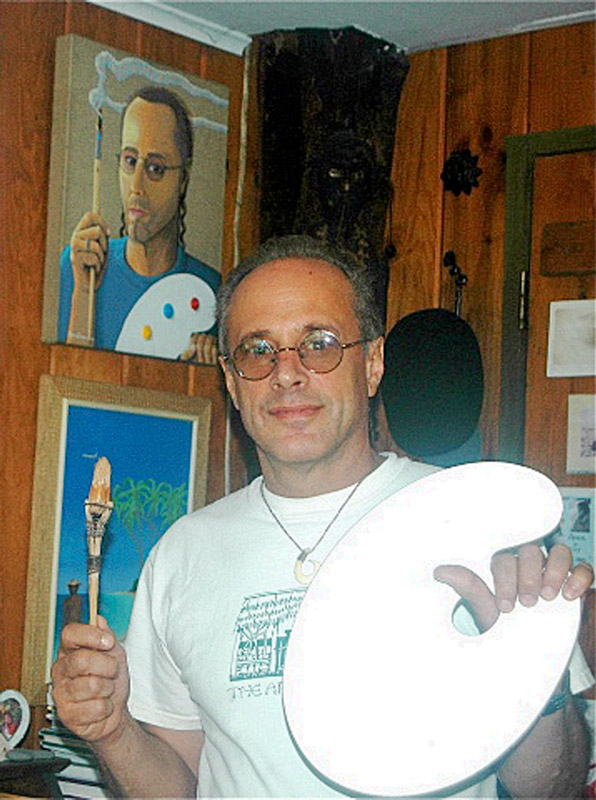
Ken Love: Hawai‘i’s Fruit Guru & Avocado Advocate

By Devany Vickery-Davidson
Ken Love personifies the word “localvore.” He has been passionately preaching about local fruits and vegetables long before it was in vogue.
I first heard of Ken in 2008, when reading Adam Leith Gollner’s book, The Fruit Hunters: A Story of Nature, Adventure, Commerce and Obsession. According to the book, Ken and a group of Big Island fruit fanatics refer to themselves as “The Hawaiian Mafia.” One of their self-appointed jobs is to seek out grocery stores, restaurants and farmers markets falsely selling fruit and vegetables labeled as “local.”
Ken shares his enthusiasm for island-grown produce and has become a leading researcher, compiling information and sharing his knowledge throughout Hawai’i and across the Pacific Ocean in both directions. He is part of an extreme group of localvores with a commitment to fruits grown on Hawai’i Island. He is both educator and instigator in this close-knit community of growers, chefs and consumers that call the Big Island of Hawai‘i home. His life is “slow-food squared.” Radical, passionate and driven, he works tirelessly to bring Hawai’i Island to a proper balance of sustainability —perhaps even tipping the scales whenever he can towards tropical fruit.
If you knew Ken Love some 25 years ago, you would hardly have expected him to become a leading expert in Hawaiian fruit. Ken was a wire-service photographer based in Chicago, where he grew up on the South Side. His beat was Asia and he occasionally ended up in Hawai’i on assignment or on his way back to Chicago. He was fascinated and appalled at the exotic mangoes, avocados and papayas he saw rotting on the roadsides of Hawai’i Island.
Eventually he decided to move to Hawai‘i, much closer to Japan, where he frequently worked. He bought a coffee plantation in West Hawai‘i and started producing the local “gold”—Kona coffee. He now says that the coffee plantation idea was one sold to him by an eager real estate agent and his own susceptible desire to become a farmer of some kind. Ken eventually sold the coffee farm and ventured on to grow and promote exotic tropical fruit.
He works with Hawai’i Island farmers and chefs to promote Hawaiian produce and determinedly champions the cause of local fruits to grocers and wholesalers, even though it sometimes seems to fall on deaf ears. However, there are people listening on the consumer end, and it is his hope that the market will drive the demand. Hawai’i Island chefs are also listening and some are getting on the local bandwagon in a big way.
Executive Chef James Babian at the Four Seasons Hualalai Resort is one of those chefs. In June, he and his staff put on an extensive Avocado Extravaganza for the Kona-Kohala American Culinary Federation. Part of the luncheon included an avocado tasting and the result was a feast for both the eyes and the palates of the lucky ACF members that were at the event. Chef Babian utilizes produce and meat from more than 160 local farms and ranches in his kitchens at the Four Seasons. He also supervises a garden on the resort property.
Along his path to becoming the “Hawai‘i Fruit Guru,” Ken traveled the world to learn more about growing and producing unique tropical fruits. He also studied close to home, discovering among other things that there are more than 200 varieties of avocados on Hawai‘i Island. This is a result of three centuries of traders who ate avocados on their passage from Mexico, Central America and West India, saving the seeds of the ones they liked. Those seedlings were planted and flourished in the ideal climates and soil of Hawai‘i Island. Japanese coffee growers on the island grafted and cross-bred varieties, creating even more subdivisions of the species. This is why today some of the avos bear names like Masami, Yamagata, and Ohata.
Over time, cross breeding and cross pollination—both intended and accidental—created an island with more types of avocados than any other place in the world. In some places on Hawai’i Island, there are entire orchards of avocados and in others, just a tree here or there on residential property. If you hike back into many wooded lots around the big island you will find random avocados growing and thriving. Almost everyone has friends with trees and, when in season, they are shared like the abundant zucchini of mainland gardens. Yet, still, many tons of our local avocados go to waste.
Because of the unique climate zones and incredible variety of avocados, island residents have a choice of several kinds of avos at any given month of the year. The farmers markets are full of them in astounding shapes and sizes as well as ranges of fat content; some so buttery you spread them and others with less fat and more firmness for an assortment of uses. The California Hass has 8 percent fat where many Hawaiian varieties like the Kahalu’u tip the scales at 25 percent. It is not like the mainland where you only have two kinds to choose from, one being the Mexican /Californian Haas and the other being the larger, thin-skinned Florida avocados, both of which Love writes off as flavorless in comparison to the Hawaiian varieties.
The abundance of varieties is actually a detriment to selling avocados. At farmers markets, only educated consumers know which avos are better for what uses, or when to tell if they are fully ripe. Grocery chains want a single specific variety of uniform size and shelf stability. Because Hawai‘i doesn’t have huge plantations growing industrialized fruit, wholesalers and grocers rarely buy Hawaiian avos, even though the flavor is far superior and there are many more sources. Local grocery chains all over the Hawaiian Islands prefer to pay $2.30 a pound for California imports whereas local avos are only 60 to 80 cents a pound.
In 2007, Love was part of a study on avocados which found that Hawaiian farmers produced over 800,000 pounds of avocados, but nearly half of that went to waste. While more than 350,000 pounds of prime avocados rotted on the trees here, Hawai’i’s supermarkets imported more than 1.5 million pounds of avocados from California and Mexico. Continued efforts to educate the public are starting to pay off, but ever so slowly. Hawai’i Island’s Natural Food Grocers such as Island Naturals and Abundant Life purchase avocados from local growers, and restaurants are buying more and more locally.
Exporting is not the answer to the rotting fruit. For more than 100 years, Hawaiian avocados have not made their way West. In 1908 the California avocado growers got the Hawai’i avocados banned because fruit flies came along with the crops. Small and especially organic growers do not find fruit fly treatments economical. Ken Love says the answer for Hawai’i is to persuade local markets to change their buying habits.
As if islanders need more than taste as a reason to eat avocados, there are health benefits to them. There are 13 vitamins that the body absolutely needs: vitamins A, C, D, E, K and the B vitamins (thiamine, riboflavin, niacin, pantothenic acid, biotin, vitamin B-6, vitamin B-12 and folate). Avocados naturally contain these vitamins as well as monounsaturated fats (3g per serving of avocado) which helps to lower blood cholesterol if used in place of saturated fats, and lutein (81.3 mcg per serving)—a carotenoid that may be associated with a lower risk of eye diseases. Lutein is also an important antioxidant that may help your eyes stay healthy while maintaining the health of your skin. Lutein’s nutritional support has been linked to promoting healthy eyes by reducing the risk of macular degeneration, the leading cause of blindness in adults 65 years of age and older.
The fifth annual Hawai’i Avocado Festival will be held on February 19, 2011, in Captain Cook (see sidebar.) Get out and celebrate the Hawaiian avocado!
Much of Ken Love’s extensive research on Hawai‘i fruits can be found at his website. You can also order posters showing Hawai‘i Island tropical fruits as well as a variety of specific fruits such as mangoes, avocados, and citrus


